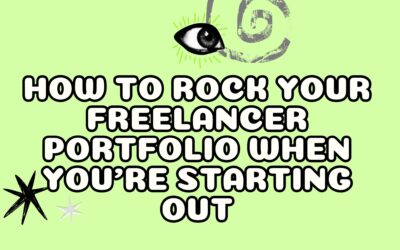Written by Rochi Zalani.
You’re tired of working for someone else, and you want to start freelancing — maybe as a side hustle on the weekends or because you want to wave goodbye to your day job.
The good news? You’re in luck: 62% of companies already hire freelancers, while 66% plan to hire more freelancers in the next few years. What’s even better is you don’t need any experience to begin freelancing (wondering what a freelance writer does? Read the guide).
No wonder 38% of people freelanced in 2023 — that’s an increase of four million people from the year before.
The bad news? Starting your freelance career can be terrifying. You’re completely new and have no idea where to begin, there’s confusing and contradictory information out there, and the field comes with a ton of uncertainty.
Luckily, you don’t have to do the tedious guesswork with this guide. You’ll learn exactly how to begin freelancing, things to keep in mind, and all the secret ingredients needed to succeed.
I’m going to walk you through the pros and cons and what you can do right now to start freelancing. You’ll also find out the legal requirements (disclaimer: I’m not a lawyer!) and three things you should consider before you start freelancing.
Let’s go!
Pros and cons of a freelancing career
There are two sides to everything.
Here’s the brutal truth: Freelancing (especially full-time) isn’t for everyone. And that doesn’t necessarily have to be a bad thing. Check if you have the right qualities to become a successful freelancer.
So, how can you know if spending time and resources on building a freelance career is the right choice for you? Evaluate if the pros outweigh the cons.
Pros
#1: Being your own boss
Want to work less in the sunny summers? You can do it. Don’t want to work the traditional 9-5 working hours? No one can force you. Love working in cute cafes? Get ready to go.
You choose your own hours, work location, and the amount of workload you want.
73% of freelancers in Freelancer Study 2023 cited the freedom to be one’s own boss as their primary reason to jump into freelancing.
#2: Working on different projects
A company no longer ties you down, so you can choose to work on multiple projects rather than stay stuck in the mundanity. 44% of freelancers say the variety of tasks is why they decided to become a freelancer.
And the best part? You get paid to learn new stuff. For example, if you want to know about influencer marketing and find a way to write about it as a freelance writer, you not only learn more about the field but get paid to do so. Win-win, don’t cha think?
#3: Flexibility
Freelancing and flexibility go hand in hand. And flexibility, as it turns out, is the secret sauce to happiness at work: 68% of freelancers say going freelance has improved their quality of life.
Not only are you not answerable to anyone, but you also have complete control over most of your work-life things: how many hours you work, which projects you choose, and when you decide to go on holiday.
Cons
#1: No employer benefits
The flexibility perk with freelancing comes at the cost of employer benefits.
Many companies provide health insurance, workplace pensions, and paid time off to their employees — something freelancers have to plan and do independently.
#2: Irregular income
While a consistent workload is definitely a viable possibility in freelancing, it’s nearly impossible to have the exact amount of money hit the bank account each month. There’s overflowing cash in the busy seasons and dry months during the holidays.
36% of freelancers say irregular income is their biggest challenge with their freelancing career. But the same study also highlights 52% of freelancers consider a higher income to be one of the main benefits of freelancing.
Side note: A little planning of taking a “fixed salary” from your freelance business can make this con disappear altogether.
#3: Admin tasks, taxes, and accounting
The other side of being your own boss (and business owner) is you have the ultimate responsibility for filing taxes, responding to clients, and managing your freelance business accounts.
You can slightly soften this con by hiring an accountant to help you with taxes and other financial best practices.
Many freelancers also hire virtual assistants or interns to help them with admin tasks.
After understanding the pros and cons, examine if any con is a dealbreaker for you to venture into freelancing.
If you have a kid on the way, for example, it might not be the best time to start your full-time freelance career. But the best part about freelancing is you can do it as a side hustle and make it full-time once you feel comfortable.
Not to mention, many cons have easy workarounds and get less and less aggravated as your freelance business becomes more established.
What can you do right now to begin freelancing?
Congrats! You’ve thoroughly examined the advantages and disadvantages of freelancing and decided to take the leap (or just dip your toe for now). What do you do next?
Here are three things you can do right away to take your freelance business off the ground as a beginner:
#1: Define your primary service and potential clients (and stick to them)
The first thing you can do is define what service you can offer your ideal clients. For example, if you want to be a freelance writer, you can narrow down your service to any one or two of the following:
- Blog writing
- Long-form writing (eBooks, whitepapers, etc.)
- Video scripts
- Copywriting
- Case studies
- Landing pages
- …And so much more
Next, define your ideal freelance client: What industry do they work in? What kind of products do they sell? You don’t need to get super specific here right off the bat, but a general overall direction is helpful.
To continue our example, you can be a freelance writer offering blog writing in the B2B SaaS industry.
As you continue to grow as a freelancer, you can continue narrowing this down. For example, your ideal client is in the B2B SaaS space, selling products related to HR, productivity, or marketing with a content strategy in place.
Why should you stick to just one primary service or client?
Won’t offering multiple kinds of services and taking any and every type of client be more profitable?
It might sound counterintuitive, but saying yes to everything will scatter your freelance business and spread you so thin that you lose more money than you make. Why? Because you’re running in a million different directions.
Saying yes to everything also holds you back from becoming an expert in any one industry and type of service.
Narrowing down also saves you time in the long run. For example, if you decide to say yes to every freelance writing project coming your way — from motor companies to direct-to-consumer brands — you’ll have to start from scratch each time you onboard new clients: Learning about their industry, the trends in the space, and the type of clients.
But, how do you decide what services you should offer and to what clients?
This should be a mix of your existing skills, what you enjoy, and what’s lucrative in the market.
For example, if you’ve worked in the ecommerce industry as a full-time employee for three years, it makes sense for you to choose to work with companies in the same industry in a freelance capacity too.
If you’re a beginner and don’t know what’s lucrative in the market, examine job boards like Upwork and see what kind of professionals brands are currently hiring. Pick what services are in demand and overlap it with your offering.
For reference, according to Freelancer Study 2023, the highest hourly rate for freelancers is in the energy industry — followed by banking, industrial, and insurance.
What if you’re interested in multiple industries and want to dabble with many different kinds of services in your freelance business?
Begin with one industry and one service for your primary offering. You can always expand it later — that’s the beauty of flexibility in freelancing.
The aim, in the beginning, is to get the ball rolling — which is easier to do once you have a focused path.
Side note: Don’t use bidding sites to apply for freelance gigs. Why? There’s a ton of competition in these types of jobs. That means freelancers are hired based on who’s the cheapest rather than who’s the best fit.
So, how can you find your ideal future clients?
One of the best ways is doing cold outreach. Don’t worry, it’s not as scary as it sounds! (If you need a hand with pitching, check out Pitch & Prosper. You’ll find out *exactly* how to find high-paying clients, and you’ll get helpful scripts, tutorials, and even an interactive tracker.)
If you’re not feeling confident about branching out to strangers just yet, try turning to your existing connections, aka your nearest and dearest. Your family, friends, or friends of friends could be the perfect starting point for landing a gig.
Another place to start is good old Twitter. I mean X. (You know what I mean.) And LinkedIn.
Still not enough ideas? Here are 35 more ways you can find your first freelance writing job.
#2: Set your base price
Have a starting rate ready before you approach potential clients. This doesn’t mean you have to have your rates totally figured out or have them set in stone. But you should have a vague idea.
For example, if you’re a freelance writer, decide what you will charge for 1,000 words. Let’s say you settle on $100. That becomes your base rate.
Now, when you communicate with potential clients, you can take the driver’s seat and respond: “My rates for 1000-word blog posts begin at $100 and increase from there depending on word count, the scope of work, and other details of the project.”
But, how do you know what to charge, especially as a beginner? The truth is there’s no standardised price structure in freelancing. The rates will always vary depending on:
- Your experience in the field
- Industry
- Project deliverables
- Scope of work
- Urgency
- Type of client
- Type of freelance service offering
Hot tip: Charge more than you think you deserve. 64% of freelancers say the biggest mistake they made when they began freelancing work was charging too low. And definitely don’t work for free for the “exposure”. Exposure won’t pay the bills!
Here’s how I made $2,000 in my first month of freelancing (without any prior experience).
How do you present your quote to a client?
You could just slap your figure in an email… but sending a polished proposal document could give you the edge you need to secure the job.
Not only do proposals look more professional (making potential clients feel more at ease with you), but templates save you time because you can use them over and over again.
If you’re not sure where to start with putting together a proposal template (or any template, for that matter), check out Workflow Wizard for all the templates, scripts and tutorials you need for a streamlined client process.
Although a streamlined process might not seem important right now, having systems in place from the start will help you become a more profitable freelancer.
#3: Make mock work samples
Surprise alert: You don’t need clients to make a portfolio. Make mock samples of your work online.
Why do you need samples?
Work samples allow you to “show, not tell” your clients about your skills. You can establish your work quality and charge more by having high-quality pieces to show. Most clients would also feel more confident about investing in you once they’ve assessed the quality of your work through your online portfolio.
Also, add any testimonials or results you’ve delivered for past employers in your portfolio to add credibility and authority to your reputation as a freelancer.
With your service offering, target market, and base rate ready, you’ll have an idea of what kind of samples you need to showcase to potential clients. For example, if you want to be a freelance graphic designer, create logos for a fictitious company.
You don’t need to purchase a domain name and a website to publish samples of your freelance work (unless you’re offering freelance web design services). You can post samples on free freelance platforms like Medium or Vocal or send them via a Google Drive link.
What are the legal requirements to begin a freelance career?
You can delay legally incorporating your freelancing business, but doing it sooner rather than later might save you future headaches.
Here’s the information you need based on what country you file your taxes from:
Disclaimer: I’m not a lawyer, and this isn’t legal advice. I’d recommend consulting a lawyer and checking the requirements with your local government because the rules for freelancers differ in every country and/or state.
But it’s not just the legal stuff you should have figured out before you venture into freelancing.
What are the other things you should consider before you start a freelance business?
Freelancing is a risky game — especially at the beginning. But the truth is, it doesn’t have to be. Here are some things you should do to make freelancing easier (and safer) for you:
#1: Have an emergency fund for three to six months
Many freelancers make the mistake of jumping into freelancing with no backup plan or security and get disheartened when they cannot earn for a few months.
Have three to six months of your expenses covered before you step into the world of full-time freelancing.
This will look different if you have kids or other dependents on your income. In that scenario, make the leap gradually — start freelancing on the side and go full-time when you have a solid emergency fund and steady clients.
#2: Building relationships with other freelancers
Freelancing can get lonely. While there is no office politics, there are no coworker friends to celebrate your wins either.
This is why it’s essential to be part of a community. There are freelancer communities for everything — from freelance writers to freelance motion designers. If nothing else works, find the right people on X (the artist formerly known as Twitter). Other freelancers are part of your tribe — focus on collaboration over competition.
A good side effect of building these long-term relationships is getting the referral ball rolling. (And you never know, your new freelancer pals might have more work than they can handle, so they could give some to you!)
#3: Marketing yourself to attract clients
It’s not necessary to be active on social media websites like LinkedIn and X, but it certainly helps.
It’s an excellent way to build new relationships, get yourself out in front of more potential clients, and provide social proof about your freelance services.
What can you post about? Here are some tips:
- Your opinion about a trend in the industry you’re looking to work into
- Testimonials or a positive email or results delivered to previous clients
- What your day-to-day looks like as a freelancer
- How you provide the best service to your clients
- Your expertise in your primary service offering
- Any piece of published freelance work or sample
Remember, marketing is all about experimenting (and it’s definitely not just about the likes). A lot of potential clients are lurkers (meaning they might not actively ‘like’ or comment on your content), so they might be absorbing more than you realise. Don’t give up!
And although you don’t need your own website to publish your samples, a simple website can be a great way to show potential clients who you are, what you do and how you can help them.
The trick is to focus on one step at a time. You could start with a basic one-page website, and keep adding to it as you grow.
#4: Keep learning
One of the most important things you can do to become a successful freelancer is constantly learning and developing your skills. And I don’t just mean around your craft, but in the business side of things too, like time management.
There are loads of free resources out there to help you get started, like blogs, podcasts and YouTube videos.
Once you’ve got your foot in the door, investing in courses can be a great way to expand your knowledge and save you time. (Interested in a career in freelance writing? Check out the 7 options for courses I recommend when you’re starting out.)
After all, one of the best ways to be a successful freelancer is always delivering quality work!
How to Start Freelancing: What Next?
Even though you now know how to start freelancing, becoming a freelancer ain’t no cakewalk. But luckily, many have done the legwork before you, so you don’t have to. (Phew!)
Ready to land your first client? I’m talking:
- Ways to market your freelancing business (passively *and* actively!),
- Creating a minimum viable service (and what that actually means), and
- Quick activities you can do NOW to get a few clients……
Download ‘How To Get Your Next Client’, your guide to tried-and-tested strategies and more.
The best part? It’s completely free (although it shouldn’t be).






0 Comments